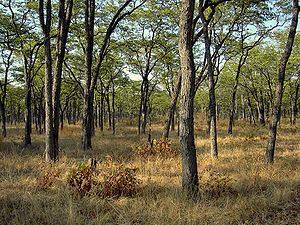You can help expand this article with text translated from the corresponding article in Spanish. (August 2015) Click [show] for important translation instructions.
|
| Zambezian and mopane woodlands | |
|---|---|
 Mopane woodland in South Luangwa Valley, Zambia | |
 Map of the Zambezian and mopane woodlands ecoregion | |
| Ecology | |
| Realm | Afrotropic |
| Biome | Tropical and subtropical grasslands, savannas, and shrublands |
| Geography | |
| Area | 473,200 km2 (182,700 sq mi) |
| Countries | Botswana, Eswatini, Malawi, Mozambique, Namibia, South Africa, Zambia, and Zimbabwe |
| Conservation | |
| Conservation status | relatively stable/intact |
The Zambezian and mopane woodlands is a tropical and subtropical grasslands, savannas, and shrublands ecoregion of southeastern Africa.
The ecoregion is characterized by the mopane tree (Colophospermum mopane), and extends across portions of Botswana, Malawi, Mozambique, Namibia, South Africa, Eswatini, Zambia, and Zimbabwe, including the lower basins of the Zambezi and Limpopo rivers.
The more humid Southern Zanzibar-Inhambane coastal forest mosaic and Maputaland coastal forest mosaic ecoregions lie between the Zambezian and mopane woodlands and the Indian Ocean. The Zambezian and mopane woodlands lie generally at a lower elevation, and has lower rainfall, than the neighboring miombo woodlands ecoregions, which occupy the plateaus and escarpments above the river lowlands. It is bounded to the southwest by the Drakensberg Range and Southern African Bushveld and Drakensberg montane grassland, woodland, and forest ecoregions. To the west, it transitions to the drier Zambezian Baikiaea woodlands and Kalahari Acacia-Baikiaea woodlands on the Kalahari sands of the Southern African Plateau.